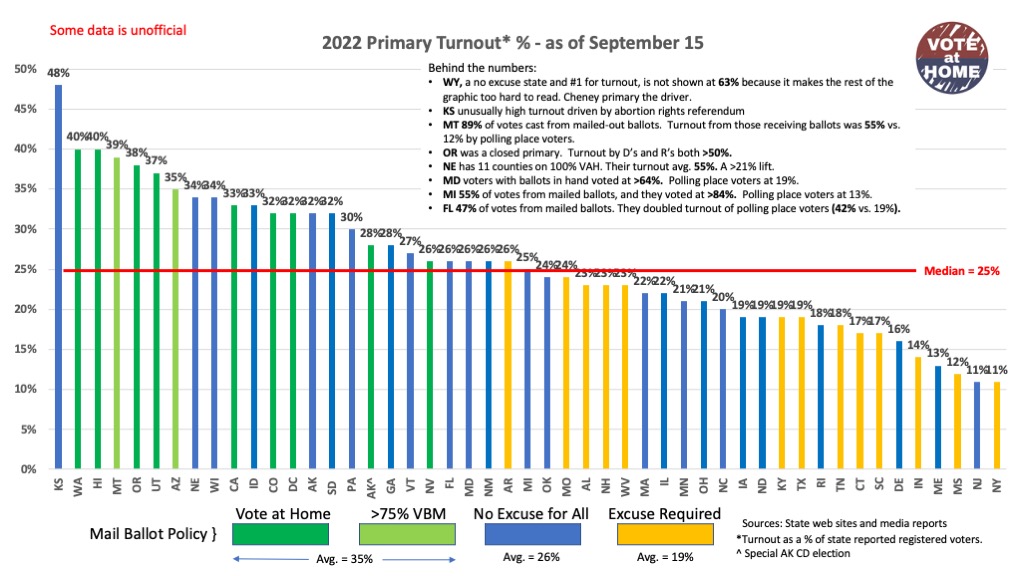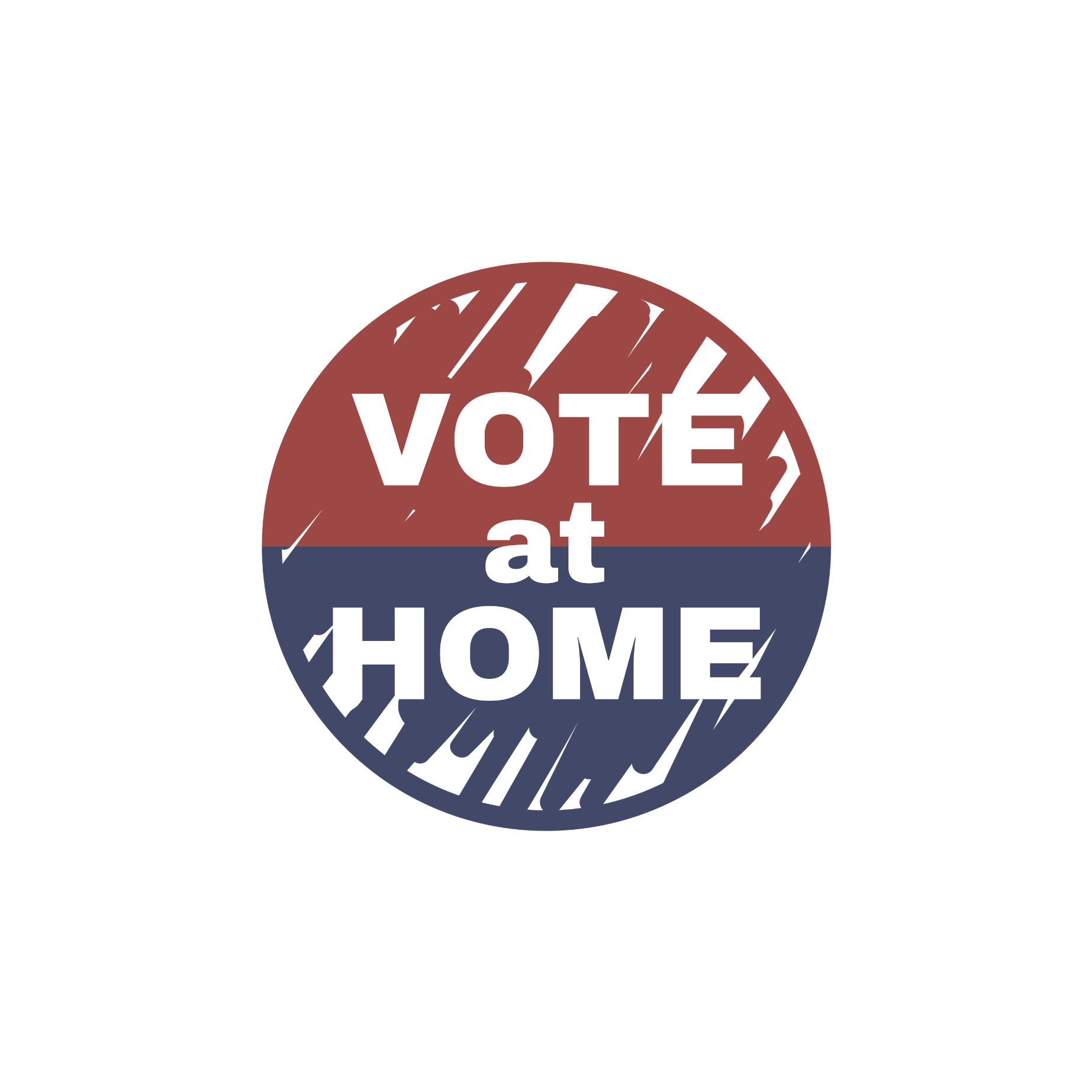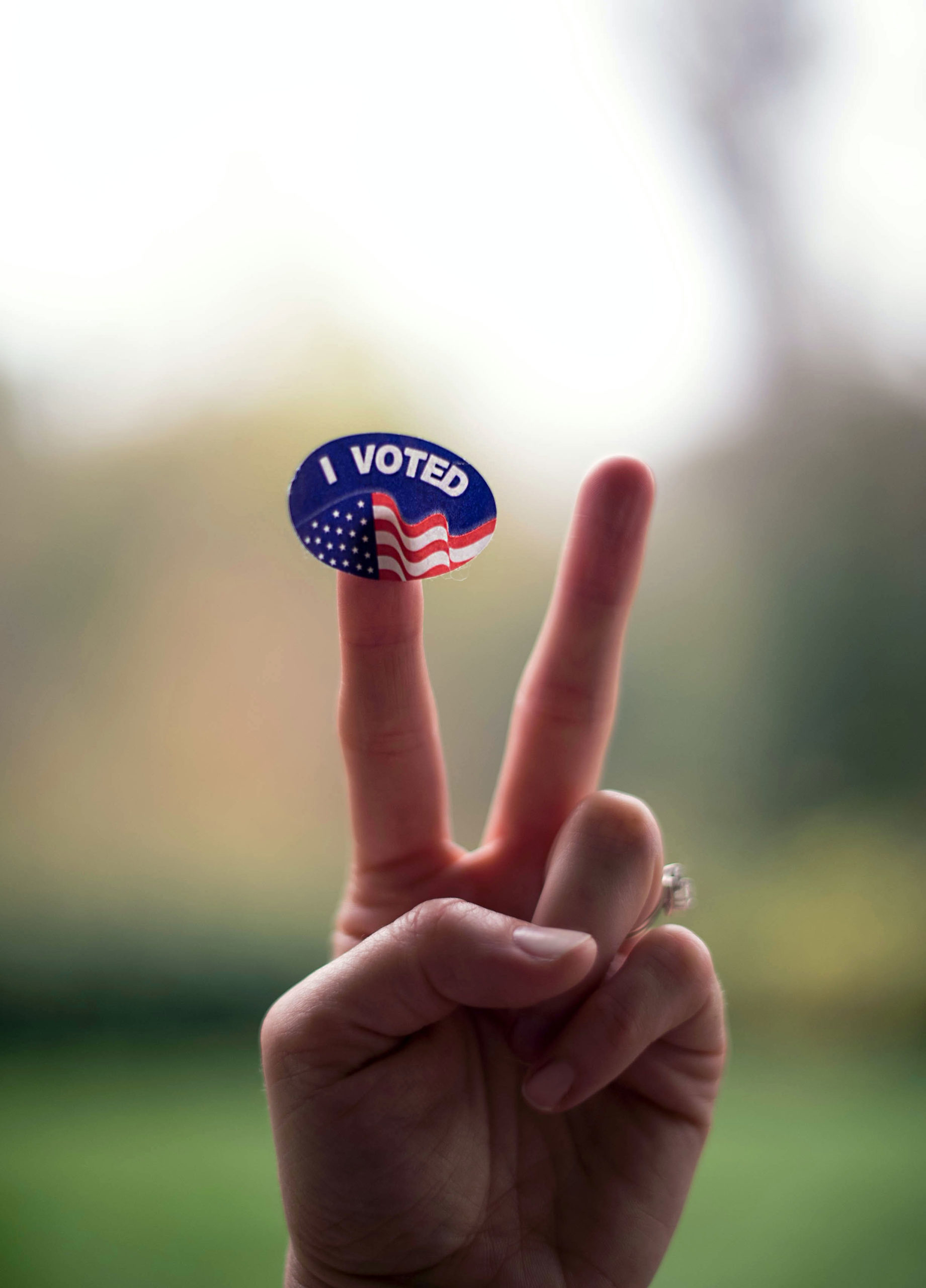AP – Michigan election officials would begin processing absentee ballots two days before the Nov. 8 election under legislation approved Wednesday in hopes of avoiding delays in counting, with absentee voting expected to remain a popular option.
Voting Explainer: In Many States, There’s a Process to Fix an Error With Your Ballot
NPR – During big U.S. elections, hundreds of thousands of mail ballots are typically thrown out and left uncounted. In 2020, for instance, more than 560,000 ballots were rejected (that’s nearly 1% of the total).
Experts say ballot rejections are largely the result of relatively minor voter errors, often associated with security measures that are designed to verify a voter’s identity.
That’s why about half of states have a process in place to help voters fix their mail ballots if they do make a mistake. It’s known as ballot curing.
Deliver My Vote Education Fund, National Vote at Home Institute, and the Andrew Goodman Foundation Announce New Research Publication
Deliver My Vote Education Fund, in partnership with National VoteAt Home Institute and The Andrew Goodman Foundation, is proud to announce a new research publication, Vote-By-Mail: Modeling Voter Participation in the 2018 Midterm Election, examining the difference between five vote-by-mail policies in place in the 2018 midterm elections and the impact of the policies on voter turnout.
“Deliver My Vote is proud to be the only national nonpartisan organization leading with vote-by-mail strategies, building a sustainable grassroots, field-based model of organizing for voter access, education, and research, while partnering and growing strategic capacity with local organizations. This research demonstrates that there are indeed opportunities to engage with and empower young voters and voters of color to access their ballots through the vote-by-mail process and build toward a stronger, more representative democracy. We are encouraged that states are expanding vote-by-mail options to give voters more opportunity and choice and the evidence supports the need for such access.” – Amanda Pohl, Executive Director of Deliver My Vote Education Fund
“This rigorous study makes an important contribution to an increasingly large body of evidence revealing that when mailed-out, paper ballots are made far more accessible, voter turnout goes up significantly,” noted Phil Keisling, chair of the National Vote at Home Institute. “This doesn’t just help voters — it strengths our democracy and makes it more representative.” As Oregon Secretary of State, Keisling led the 1998 effort to create the nation’s first “Vote at Home” election system in which all active registered voters automatically receive their ballots in the mail, a system that eight states will use in the 2022 midterms.
“The Andrew Goodman Foundation is thrilled to partner with Deliver My Vote on this exciting new research. Young voters are one of the most powerful forces in our democracy, so it is imperative that they are educated about what their voting options are and have the accessibility to cast their ballot by-mail or in-person. We are excited to continue our work with Deliver My Vote to ensure that young voices are heard in the upcoming midterms and future elections.” –Charles Imohiosen, Esq., President and CEO of The Andrew Goodman Foundation
The COVID-19 pandemic caused many states to respond quickly to the changing needs of voters – namely by expanding vote-by-mail programs in many states. This provided an opportunity to expand access, grow participation, and change the way elections are run. As we enter the election season two years later, many of these expanded policies remain in place. By adopting and strengthening vote-by-mail policies, states encourage access to the ballot and therefore reduce barriers to voter participation universally. These are bedrock principles to a healthy and inclusive democratic system. Research conclusively shows that vote-by-mail policies will help us achieve these goals.
In Vote-By-Mail: Modeling Voter Participation in the 2018 Midterm Election, the researcher demonstrates that more expansive vote-by-mail policies, especially Permanent Mail Ballot Options and Vote at Home policies, increase voter turnout. For example, counties moving from either Excuse Required or Excuse Required with anAge Waiver to No Excuse vote-by-mail would increase turnout 2 or 3 percentage points. Counties with No Excuse vote-by-mail increase another 2 to 3 percentage points when moving to a Vote at Home or Permanent Mail Ballot Option policy. Overall, for Excuse Required counties, moving to Vote at Home would increase turnout 4 percentage points; 5.1 percentage points if they moved to Permanent Mail Ballot Option.
Additionally, the research finds that Vote at Home policies are particularly impactful among younger voters across racial and ethnic groups. When looking at county-level data, younger counties with a median age of 44 or lower that have adopted VoteAt Home policies show a 4.2% boost in turnout. By exploring how vote-by-mail policies have already impacted the political landscape of the United States, we identify potential to radically expand access and participation for all voters, particularly young voters. This is especially relevant as young people are becoming more politically active and consequently exploring voting options.
These findings are consistent with Deliver My Vote Education Fund’s previous research during COVID-19 that shows young voters and voters of color turn out in higher numbers when given vote-by-mail options. In Vote By Mail in 2020 and Our Opportunity for 2022, we found that, state-by-state, low propensity voters were 10x more likely to cast a ballot if they had applied for a mail-in ballot in 2020. We also observed that young voters, especially voters of color, were more likely to vote if given vote-by-mail options. Voters of all backgrounds embraced vote-by-mail as a safe way to vote during the pandemic, while also realizing the remarkable convenience.
Effective vote-by-mail policies are critical tools to improve participation in elections at local, county, state, and federal levels. If voter activation is a priority, this research demonstrates that more expansive VBM policies lead to increased voter turnout, particularly among young voters who are often the most impacted by voter suppression tactics and restrictive vote-by-mail policies.
About Deliver My Vote Education Fund
Deliver My Vote Education Fund is a non-partisan, non-profit 501(c)3 organization focused on research and education about voting-by-mail. We support deeply embedded on-the-ground organizations with tools, expertise, and resources to build trust in the vote-by-mail process within historically disenfranchised communities of color. As an education fund, we focus on empowering all Black, Latino, AAPI, Indigenous, immigrant, and young voters within specific counties or localities that our grassroots 501(c)3 local partners identify as unserved or underserved areas.
About National Vote At Home Institute
The National Vote at Home Institute is a nonpartisan nonprofit organization that aims to increase voters’ access to, use of, and confidence in voting by mail, or “voting at home” – in which voters receive mailed-out paper ballots; return them either by postage-free mail or in-person to a wide range of accessible, convenient, and secure locations; and can track them online, in real-time, to ensure their vote is counted.
About The Andrew Goodman Foundation
The Andrew Goodman Foundation’s mission is to make young voices and votes a powerful force in democracy by training the next generation of leaders, engaging young voters, and challenging restrictive voter suppression laws. The organization is named after Andrew Goodman, a Freedom Summer volunteer and champion of equality and voting rights who was murdered, alongside James Earl Chaney and Michael Schwerner, by the KKK in 1964 while registering BlackAmericans to vote in Mississippi.
Modeling Voter Participation in 2018 Midterm Election
In this research, we examine the difference between five vote-by-mail policies in place in the 2018 midterm elections. We use statistical modeling to understand the effects of different vote-by-mail policies nationwide and estimate what might have changed in 2018 based on different voting systems. In general, we find that turnout increases as states move along the vote-by-mail policy continuum, removing administrative obstacles for voters in the process. Additionally, turnout gains are largest when counties progress several steps from more restrictive policies to less restrictive policies, and the Vote at Home policy has the most potential to impact young voters.
Drop Box Popularity Holds Strong Despite Attacks and Misinformation
Votebeat – A Votebeat analysis of data provided by multiple counties shows ballot drop boxes remain a popular voting option for all Arizonans, including in Republican-dominated areas. In several of the counties Votebeat analyzed, drop box use increased in this year’s primary compared with past primaries.
The ‘Cost’ of Voting in America: A Look at Where It’s Easiest and Hardest
New York Times – The two categories given the most weight, according to Scot Schraufnagel, a political scientist at Northern Illinois University and an author of the study, were ease of registration to vote and the availability of early voting, both in person and by mail. The study’s emphasis on early-voting options meant that states like Washington and Oregon, where voting is conducted entirely by mail, ended up at the top of the rankings.
The Newest Democratic Fight to Make Vote by Mail Easier
Washington Monthly – In the lead-up to this year’s primaries, Ohio state Representative Michael Skindell got a call from a voter with considerable clout—his mother. Like many in the state, she felt frustrated having to apply, year after year, to receive mail-in ballots––especially during this year’s electoral chaos, when a tumultuous redistricting battle in the state led to primary elections in both May and August. Why, she asked, couldn’t she just sign up once and be done with it—that is, become a permanent absentee voter?
Judge Allows Delaware to Continue to Prepare for Mail-In-Voting, After Ruling It Unconstitutional
WDEL – A Chancery Court judge has ruled that the Department of Elections can continue to take applications for a potential mail-in-voting system for the General Election, but whether any votes will actually be cast that way during November’s election remains in doubt.
Cost of Voting in the American States: 2022
(Election Law Journal) — A recent nonpartisan academic study that ranked all 50 states based on the amount of time, energy, and resources people must make to vote was released this week. To no surprise, of the top 10 states for ease of voting, eight are the nation’s only states conducting full vote-at-home elections in 2022, during which all voters will automatically be mailed ballots for the upcoming midterms. As for the bottom 10 states, seven require their voters to attest to a valid excuse in order to obtain a mailed-out ballot.
Mail-ballot voters turnout at higher rates than polling place voters

Since 2020, mail-ballot use has been on the rise across the U.S., resulting in more voters having access to the ballot box. The 2022 primary elections were no exception.
On average, vote-at-home states (and Montana, with 89% of votes cast from mailed-out ballots in its primary) saw 35% turnout during the primaries. This is compared to the lower average turnout in states that require their voters to request a mailed ballot for every election without needing an excuse and excuse-required states, at 26% and 19% respectively. Of the Top 10 highest-performing states, seven were full vote-at-home states. Meanwhile, in the bottom 10 states, seven require voters to have an excuse (e.g. seniors or voters with disabilities) to vote from home. Fewer than one in five registered voters participated in those elections.
The evidence is clear: vote-at-home policies promote greater voter participation thanks to easy, safe, and convenient access to mailed-out ballots.










